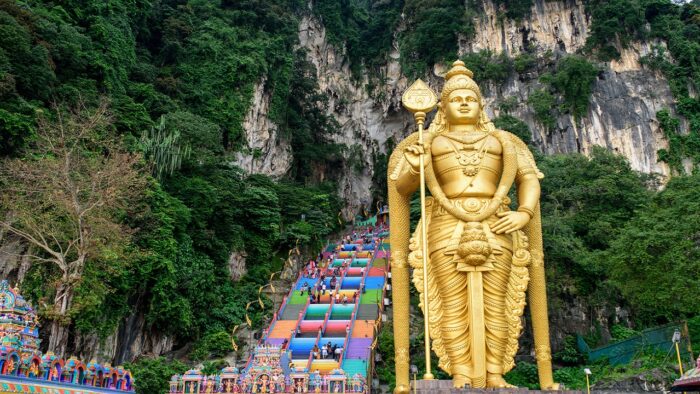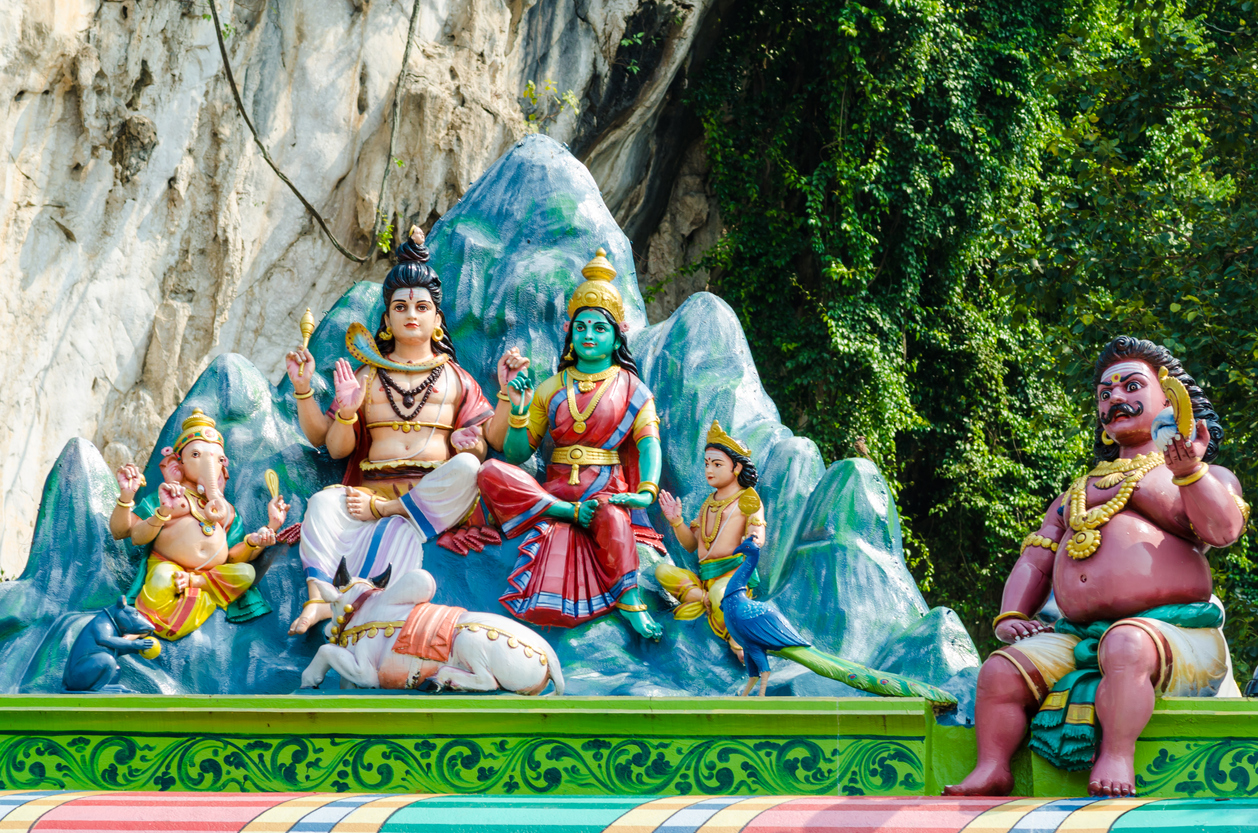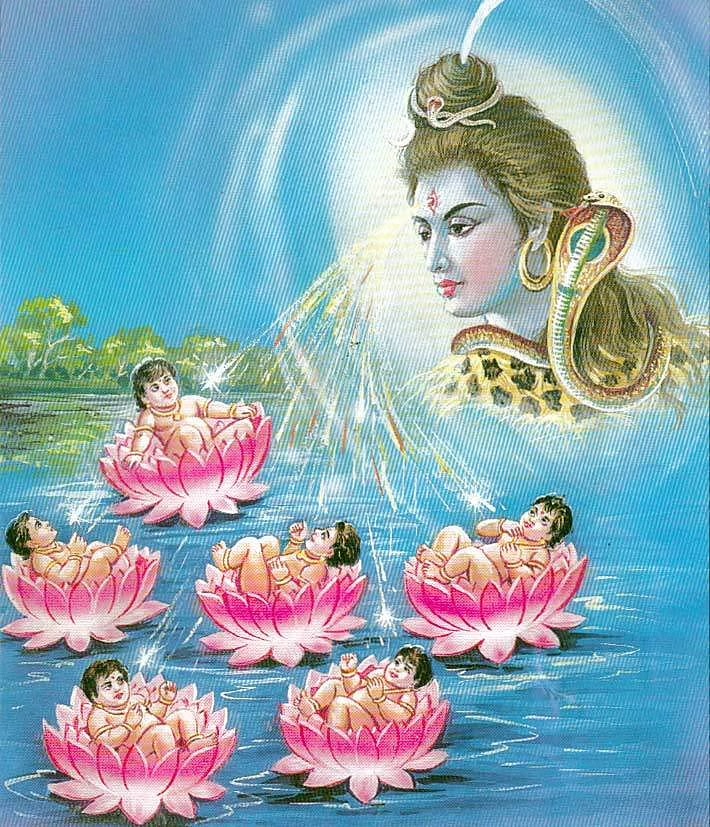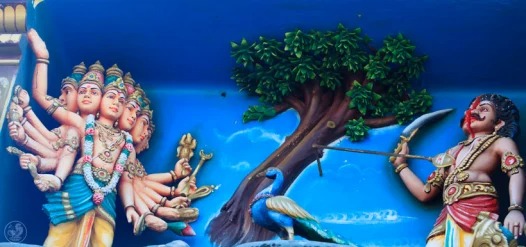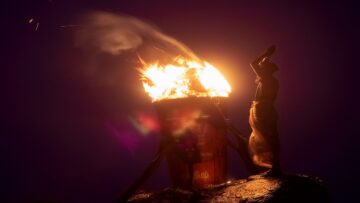Introduction
Murugan, the younger son of Śrī Śiva and Pārvatī and the brother of Gaṇeśa is the Hindu God well-known for his youth, beauty, courage and knowledge. He is known as a ‘Hindu God of War’ (Deva-Senādhipati). This name was given to him because he was the commander-in-chief of the army of Devas. He is also known as “Tamil Kaḍavul”- native Lord of the Tamils alluding to his patronage of the Tamil language. Consequently, He has a large number of devotees from the South of India, especially Tamil Nadu. He is worshipped not only in India, but also in various other countries like SriLanka, Singapore, Malaysia, Mauritius, etc. Śrī Murugan has six abodes called ‘Āru-paḍaivīḍu’ viz. Thiruchendur, Swamimalai, Pazhamudircholai, Pazhani and Thiruthani, each having interesting stories behind them. Śrī Muruga has several names, some of which are Skanda, Kumāra, Kārtikeya, Swaminātha, Ṣaṅmukha, Subrahmaṇya, Guha, Śaravaṇan, Danḍapāni, Ārumugam, Senthilvelan, etc.
Vedas about Lord Muruga
The Atharva Veda describes Subrahmaṇya as ‘Agnibhū’ as He is a form of Agni (Fire God) and the Agni held Kumāra when he was born. The most ancient Tamil Literature called ‘Tholkāppiyam’ mentions Muruga as Śeyon. Extant Sangam works glorified Lord Muruga as a red-complexioned God seated on the blue peacock, who is ever young and resplendent and the favourite God of the Tamils. Several Tamil works that portray Muruga include Paripāḍal, Āgamas and Puranas. In many Śiva temples and Devi temples of Tamil Nadu, Lord Murugan is installed on the left side of the main deity. In Tamil nadu, Lord Murugan continues to be popular with all classes of society right from the Sangam age. Kacchiyappa Śivachariar of Kumāra Koṭṭam, a scholar in Tamil literature has written the Kanda-Purāṇam (10345 verses) which covers the greatness of Lord Muruga.
Kumārasambhavam
The Devas gathered at the foot of the Himalayas and prayed to Śrī Śiva that they are eagerly awaiting the birth of His son who will help them to put an end to the atrocities of the demon Śūrapadma and his associates.
Brahmā suggested and directed Vāyu to go to Mount Kailasa, gathering all the sweet smell of Divine flowers as soothing and pleasant as the southern wind. Nandī stopped Vāyu and questioned him for his unauthorised entry. Vāyu pleaded his pardon for entering Kailasa without his permission and returned. Devas then decided to go to Kailasa with Brahma as their leader to make a fresh request and accordingly went to Kailasa with the permission of Nandī, who allowed them entry into Kailasa. They prayed to Śiva to give his son equal in power to Him to mitigate their sufferings. Lord Śiva acceded to their prayer and agreed to do the needful. Right in the presence of Devas He stood with six faces, i.e, along with the sixth face Adhomukam (facing downwards). Six sparks were emitted from the six eyes in the forehead of six faces of Śiva which radiated a lot of heat all around and made the Devas run away. When the devas again prayed, Śiva changed his form and gave darshan with just one face and re-called all the sparks emitted by him. Śiva directed Vāyu and Agni to take the six sparks to Ganges River who in turn was to take them to Śaravaṇa Lake in the South. Lord Śiva also informed that as soon as the sparks reach Śaravaṇa Lake, the sparks will unite and become my son who will kill the asuras and take care of the Devas’ welfare.
Accordingly, Vāyu carried the sparks but the heat was unbearable for him. So he gave it to Agni, who took them to the river Ganga. Due to the excessive heat energy of the sparks, the water in the Ganges began to evaporate. Ganga took the sparks to Śaravaṇa Lake. Śiva’s grace protected the water in the Śaravaṇa Lake and the six sparks united into one big column of fire and a Divine figure could be seen which was unique, multi-faceted and Supreme. The Devas felt happy to see the child seated on a lotus flower with six faces and twelve hands.
सहस्रसूर्यप्रतिमं तत्र तच्छाम्भवं मह: l
षड्वक्त्रं द्वादशभुजं द्विपादं सुमनोहरम् ll Skandapuranam I.26.16
वपुः पुपोष जगतां मंगला पुण्यवर्धनम् l
कुमारः सुकुमाराणाम् निदर्शनमभुत क्षणात् ll Skandapuranam I.26.17
Lord Śiva called the six Kṛttikās to take care of the child. When they came near the lotus, Lord Muruga transformed himself into six children. Each one was brought up by the six Kṛttikās. At that time when Lord Muruga was born in the Śaravaṇa Lake, the asuras including Śūrapadma, Siṁhamukha, Tāraka and others experienced bad dreams.
In the meantime, Goddess Pārvatī who was unable to bear the heat generated by the sparks of Lord Śiva, Her anklets hit against each other and nine gems rolled out of the broken anklets and in each of them Pārvatī’s figure could be seen. When Lord Śiva looked at them with love, nine Śaktis were born. God blessed them that they will help Lord Muruga to fight the asuras. Goddess Pārvatī learnt that Lord Śiva had created Skanda and was angry that she had lost an opportunity to bear him. She cursed all the Devas not to beget children by their wives. She also cursed the nine Śaktis but withdrew her curse at Śiva’s request and they delivered nine kids who were the great warriors of whom Vīrabāhu was their leader.
Goddess Pārvatī and Lord Śiva left for Śaravaṇa Lake with their celestial group to get their son to Mount Kailasa. When Pārvatī happily took the six children playing around the lake and hugged them with all her love, the six forms were made into one form called Skanda. All the Devas enjoyed the darshan of the Divine family of Śiva with his son Skanda on his lap and Pārvatī with Gaṇapati on her lap. This posture is called Somāskanda. Śiva told the six Krittikās that his son will be called as Kārtikeya as he was brought up by you and anyone who worships my son on the day of your star (Kṛttikā) will be blessed by him for all their desires.
At Mount Kailasa, Pārvatī rejoiced as she saw Skanda happily playing with his brother and his childish pranks and asked Śiva to tell her more about Skanda’s greatness and glory. Śiva narrates that as Skanda had been born from the sparks of his eyes, Skanda will be as powerful as him. He further told that Skanda will be known as Gāṅgeya as He was carried by River Gaṅgā and his popular name would be Śaravaṇabhava as he took a definite form at Śaravaṇa Lake. He also gets the name of Arumugam or Ṣaṇmukha as you have united the six forms into one. His Panchakshara and Taraka mantra ‘Om’ have united to become Ṣaḍakṣara i.e. Om Śaravaṇabhava. He is none other than me and He will annihilate Śūrapadma and all other asuras to help the Devas.
Skanda Mahimā – Greatness of Skanda revealed through his various names
Subrahmaṇya
ब्राह्मणानामहं देवस्सुतरां मत्सुत: प्रिये।
सुब्रह्मण्यसमाख्यात: सुरासुरनमस्कृत:॥ Skanda-puranam I.35.20
I am the Bhagavān for brāhmaṇas and therefore Brahmaṇya, my son Subrahmaṇya is even more. Hence, He is Subrahmaṇya, worshipped by both the Devas and Asuras.
Skanda
आकाम्यच यतोऽस्कन्दद्विक्रमेण जगत्त्रयम्।
तेन स्कन्दो यमोख्यातस्सुतस्ते गिरिसंभवे॥ I.35.11
He came to be called Skanda as He won over the three worlds by His valour.
Agnibhūḥ
मढूर्ध्वरेतसो यस्माल्लालाटदवह्निनेत्रत : l
अथवा भुदयं यस्मादग्निभुर्भुवनेश्वरी ll I.36.13
Since He emanated from the sparks of fire emanated from the third eye of Lord Śivas’s forehead, He is called as Agnibhūh.
Guha
गुहेति दहराकाशो वेदान्तेषुहि पठ्यते l
तन्निष्ठोऽयं गुह: प्रोक्तः सर्वहृत्कमलासन: ॥ I.36.15
It is said in Vedanta that in the centre of the heart (Hridaya Kamalam) there is space (Akasha) which is called as Guha. Since He is seated in the Hridaya Kamala of everyone, He is called Guha.
Śaravaṇabhava
शराणां यद्वने जातस्सो यं शरवणोदभ्व: l
वनं जलं शरान्तस्थतटाकस्य तदन्तरे ll
पद्मे पद्माभवदनससबभूवावनेच्छया l
तेनायं जगतां नाथः पुत्रश्शरवणोदभ्व: ll I.36.18
Since He has come out from the lotus in the middle of the lake in the forest, He is known as Śaravaṇabhava.
Gāṅgeya
गङ्गायामुदभूद्बालस्तेन गाङ्गेय ईरितः।
देवा विष्णुमुखा लोके यस्यसेना: प्रकीर्तिता: ll I.36.19
Since He is held by Ganga, He is called Gāṅgeya.
Kārtikeya
षट्कृत्तिका मुख्यरूपा ददु: स्तन्यं यदस्यवै l
पपौच तासां येनायं कार्तिकेयस्तवात्मज: ll I.35.9
As He was brought up by the six Kritthika girls, He came to be called as Karthikeya.
Swāminatha
The Supremacy of Lord Subrahmaṇya can be gauged by the fact that even as a child he reprimanded and jailed the haughty Brahma who is believed to be well-versed in the four vedas for slighting him and not knowing the meaning of ‘Praṇava’. Thereupon, Lord Subrahmaṇya himself assumed the role of the creator. Subsequently, He gave the Divine upadeṣa to his father Lord Śiva as described by the latter and became ‘Swāminatha’. His holy shrine is at Swāmimalai in Tamilnadu.
Ṣaṇmukha
Arunagirināthar in Tiruppugazh hymn ‘Eru Mayilari’ gives a vivid description of the divine function of the Lord’s six faces:
- One face seated on the back of peacock vāhana.
- One face preaches the word of wisdom to Lord Śiva.
- One face obliterates the ill-effects of past deeds of devotees who sings His glory.
- One face which directed the Spear (Vel) that pierced the Krauncha hill.
- One face which slew the inimical Sūrapadma and his clan.
- One face which came to wed Valli.
Symbols of Skanda
Peacock: The peacock as represented in the medieval period symbolized many of the meanings embodied in Murugan himself – primordiality, integration, cosmic totality. The bird also suggests a certain coalescence of polarities – sky and earth, malevolence and enmity towards the god, together with benevolence and devotion; primordial chaos and the colourful and fertile fullness of the created whole.
Rooster: In the epic mythology, we find that the bird is given to Skanda by Aruna, the celestial charioteer of the sun. The rooster is thereby ascribed solar and celestial connotations. In the South, Murugan’s rooster was inscribed on a banner, for the banner was one of the necessary paraphernalia of Tamil kings. Thus Murugan’s kingship is denoted, his bird being a protector, fecundator and fighter in its own right, and like the peacock, having both solar and terrestrial connotations. (pg.184)
Ram: The ram (āṭu or kaṭā) is used infrequently today as a vehicle for Murugan and even more rarely is depicted in one of the hands of the sculptured Subrahmaṇya, Senāpati or Ṣaṇmukha. The most important myth speaking of the significance of the ram is that which speaks of the ram running wild on the mountainside when Murugan was but a child. Created of the Ṛṣi’s sacrifice, the ram waxed out of control and terrorized the realm of the devatas. But Murugan, still only a few days old, had the ram brought to him and playfully rode it, thereby subduing it and making it his permanent instrument. This recurrent theme, intimated here, of the God’s conquest of malevolence is also illustrated by the fact that one of the heads of the six-headed Śūrapadma in contemporary enactment festivals is that of a ram.
Vel: The Vel reminds devotees that of all the forces of the cosmos, Murugan is the most powerful and that His power is paradigmatic of the power available to all who bring wisdom and will to bear on life’s obstacles. But, the lance represents more than the power of Devas or man. In contemporary ritual, the lance often represents the Deva himself, in his totality, for the lance is often used as the representation of him. Moreover, when the lance as Śakti is in the clasp of Murugan, the two together represent integration of dualities in a manner consistent with Saiva thought: Murugan and his lance are Śiva-Śakti, the cosmic pair.
Muruga and His powerful Śakti Vel are inseparable. The Vel is Jn͂āna Śakti, while the Divine consorts of the Lord, Valli and Devasena are Iccha Śakti and Kriya Śakti respectively. In fact Vel and Lord Muruga are identical and hence the worship of Vel is as good as the worship of Muruga. The Jn͂āna Vel was given to Lord Subrahmaṇya by his mother Goddess Pārvati with Her blessings to root out Sūrapadma and his mighty army.
Skanda’s playfulness crossed the frontiers of Mount Kailasa. Devas wondered if these child’s plays were transitory pranks of child Skanda or the tricks of the wicked asuras. None of the Devas could identify Skanda who wanted to prove His prowess to them and allay their fears. Devas attacked Skanda from all the four sides. The arrows fell as flowers on Him. Even Indra could least imagine that this was the Divine child who had been sent to rescue the devas from the clutches of Śūrapadma and other Asuras. When Indra pushed forward his Airavatam and attacked Skanda, Skanda shot an arrow which pierced the tongue of Airavatam which fell down and the next arrow made Indra fall down on earth. Devas were aghast with fear. Sage Nārada heard the news and hastened to Devaguru Bṛihaspati and briefed him that Devas have not recognized Skanda. Nārada and Bṛihaspati rushed to Mount Kailasa and fell at the feet of Skanda and pleaded him to forgive the Devas for their stupid mistake that they have done in attacking Him without knowing the fact that Skanda has been born to protect the Devas from asuras like Taraka, Śūrapadma and Simhamukha due to their ignorance.
Devas who were dead came back to life with wisdom. Skanda assured them that they need not fear anyone and asuras will be done away with. Skanda also gave them the wisdom to see Him fully when they saw in Him the entire Universe. Struck with this great wonder, the Devas praised Skanda. Indra bowed before Skanda and told him that He is their master and they are His servants. Skanda became the commander-in-chief of the Devas (Devasenādhipati).
Defeat of Śurapadma
Vīrabāhu, the kind-hearted messenger of Devas sent by Lord Muruga to persuade Śūrapadma to release all the Devas including Indra’s son Jayanta from prison and if he refused to set them free then he would face dire consequences including death. However, Śūrapadma declined to accede to his request to release the Devas. Śūrapadma further commented that he had heard of the small boy Muruga, who killed my brother Taraka, He pointed out to Veerabahu that he spared him only because he was a messenger and he was not supposed to harm him as per the code of conduct for kings. He further claimed that he can single-handedly finish all the Devas and there is none to win over him.
Vīrabāhu was feeling sorry that Śūrapadma casually took Muruga as only a small child. So he enlightened him about the greatness of Muruga, but to no avail. He again advised him not to invite his end by refusing to set free the Devas from his captivity. The Lord has already come to Tiruchendur after killing Tārakāsura.
Kumāra’s Velayudham pierced Śūrapadma, who stood in the mid-sea as a huge mango tree. The tree was cut into two pieces. Surapadma took his original form and tried to overcome the power of Vel, but the Vel cut him into two pieces and his body fell into the sea. Due to Lord Śiva’s special blessings, Śūrapadma did not die though his body was ripped apart into two pieces and he took two forms of a rooster and peacock and rushed to attack Muruga. Muruga took pity on Śūrapadma and gave him the wisdom to realize Him by His grace. Śūrapadma lost his anger and enmity at the very moment, all his devilish qualities were totally wiped out. Kumāra then asked the rooster to be his flag on the top of his chariot and accordingly the fowl climbed on the chariot and sat on his flag. Śūrapadma in the form of a peacock took Kumāra on his back and went around all the continents. Agni who was hitherto Śūrapadma’s flag and Indra who was hitherto his peacock were restored to their original forms by the grace of Lord Muruga. The Devas worshipped Him.
Significance of Skanda Ṣaṣṭhī
The Sanskrit word Shat stands for number six. Ṣaṣṭhī as such denotes the sixth lunar day of both the waxing and waning fortnight of the moon. Of these, the sixth day of the waxing phase is considered auspicious for undertaking special worship and austerities. Hence Ṣaṣṭhī has come to represent the sixth day of Shukla Paksha, the waxing phase of the moon. The Ṣaṣṭhī that falls on the waxing phase of the moon in the Hindu lunar month of Ashwin (Oct- Nov) is observed as Skanda Shasti.
Murugan, also known as Subrahmaṇya, Karthikeya or Skanda is the son of Lord Śiva and Goddess Pārvatī. He is a unique Godhead, who remains the rare combination of matchless valour and Supreme Divine intelligence. According to legends, it is on Skanda Ṣaṣṭhī that Lord Muruga put an end to the demon Śūrapadma. Hence, Skanda Ṣaṣṭhī is regarded as very special day for Murugan worship, when devotees observe vrata (fasting) for propitiating him and receiving His blessings.
Origin of Skanda Ṣaṣṭhī
According to traditions, Śūrapadma was a demon, who obtained many boons, became quite powerful and started oppressing even the Devatas. As desired by his parents, Lord Śiva and Goddess Pārvatī, Muruga led an army of celestial beings against the demonic forces and fought Śūrapadma, his henchman and their mighty army. The fierce battle ended on the sixth day, when Lord Muruga decisively defeated Śūrapadma and his evil forces, relieving the Devatas and the people from the clutches of his repression. This day is observed as Skanda Ṣaṣṭhī. The grateful devotees remember the heroic feat of Muruga, sing His glory for the first five days and on the sixth Skanda Ṣaṣṭhī day, they undertake vrata or fasting and offer Him special worship to commemorate His resounding victory. This triumph is also enacted in many Murugan temples as Sūrasamharam, and is held with great enthusiasm in Tiruchendur, the sea-shore temple of Lord Muruga.
Rituals of Skanda Shasti Vratam
Devotees install picture or idol of Lord Muruga at home, decorate it with flowers, light a traditional lamp, preferably a ghee lamp and incense, make offerings of fruits and flowers and special delicacies, like sweet pongal and offer worship along with the reading and reciting of texts and hymns like Skanda- Purāṇam and Skanda-Ṣaṣṭhi-Kavacam etc. Some also worship the Vel or the lance, Muruga’s principal weapon and also visit Muruga temples. Devotees begin the fast early in the morning and continue it till next day sunrise. Some observe vrata on all the six days from morning to evening.
Benefits of observing Skanda Ṣaṣṭhī Vratam
According to sacred texts, observing vratam on Skanda Shasti can bestow the following benefits: 1. Ward off negative tendencies 2. Help to overcome impediments 3. Achieve success in all endeavours.
Chanting of Skanda-ṣaṣṭhi-kavacam or Subrahmaṇya-bhujañgam shall grant sound health and attract wealth. Murugan is also the overlord of Angāraka or planet Mars and His worship can help to remove the malefic effects of Mars in the birth chart, bestow courage to face life with determination and win over the problems.
अपस्मार-कुष्ट-क्षयार्श-प्रमेह ज्वरोन्माद-गुल्मादि-रोगा महान्त: l
पिशाचाश्च सर्वे भवद्भद्रभूतिं विलोक्य क्षणात् तारकारे द्रवन्ते ll Subrahmaṇya-bhujañgam .25
Feature Image Credit: istockphoto.com
Disclaimer: The opinions expressed in this article belong to the author. Indic Today is neither responsible nor liable for the accuracy, completeness, suitability, or validity of any information in the article.

